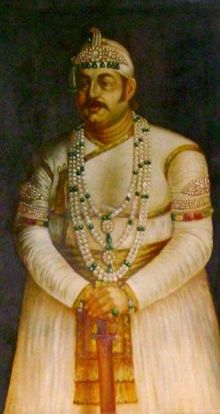Afzal-ud-Daulah
This article needs additional citations for verification. (August 2020) |
Mir Tahniyat Ali Khan Siddiqi Bahadur | |||||
|---|---|---|---|---|---|
 | |||||
| The 8th Nizam of Hyderabad State | |||||
| Reign | 16 May 1857 – 26 February 1869 | ||||
| Coronation | 1857 | ||||
| Predecessor | Nasir-ud-dawlah, Asaf Jah IV | ||||
| Successor | Mir Mahboob Ali Khan Siddiqi, Asaf Jah VI Princess Hussain un-nisa Begum Saheba, the eldest daughter (Lady Khursheed Jah) Princess Jahandar unisa begum (Lady Viqar ul umrah) Princess Parwarish unisa begum | ||||
| Born | 11 October 1827 Gufran Manzil, Hyderabad State, British India | ||||
| Died | 26 February 1869 (aged 41) Hyderabad, Hyderabad State, British India | ||||
| Burial | |||||
| Spouse |
| ||||
| Issue | Asaf Jah VI | ||||
| |||||
| House | Asaf Jahi | ||||
| Father | Nasir-ud-dawlah, Asaf Jah IV | ||||
| Mother | Sahebzadi Dilawar unisa Begum Saheba | ||||
| Religion | Sunni Islam | ||||
Afzal ad-Dawlah, Asaf Jah V Mir Tahniyat Ali Khan Siddiqi (11 October 1827 – 26 February 1869) was the ruling Nizam of Hyderabad, India, from 1857 to 1869.[1]
Realm[edit]
Asaf Jah V's realm was divided into five subahs and sixteen districts; each subah was headed by a Subedar and each district by a Taluqdar.[citation needed]
Developmental reforms[edit]
Hyderabad Medical School[edit]
He set up the Hyderabad Medical School (HMS) in 1846 which later came to be known as Osmania Medical College.[2]
Rubath for pilgrims of Hyderabad State[edit]
The Nizam's Rubath is an accommodation building purchased by the 5th Nizam for the people of Hyderabad State travelling for their Holy pilgrimage (Hajj) to city of Mecca.[3][4] It initially consisted of 42 buildings, but with the expansion of the Grand Mosque, only three buildings remain.[citation needed]
Other reforms[edit]
Other reforms during his reign, by his Prime Minister Salar Jung, included the establishment of a governmental central treasury in 1855.[citation needed]
Asaf Jah V reformed the Hyderabad revenue and judicial systems, instituted a postal service and constructed the first rail and telegraph networks. In 1861 he was awarded the Star of India.[5]
During the regime of the Nizam V- Mir Tahniyath Ali Khan Siddiqi (Afzal-ud-Dawlah), Dar-ul-Uloom, the first regular educational institution of Hyderabad, was set up in 1854.[6]
Personal life[edit]
Asaf Jah V was the eldest son of Nasir-ud-dawlah, Asaf Jah IV (Mir Farqunda Ali Khan) and his wife Sahebzadi Dilawar unnisa Begum Saheba.[citation needed]
He was married three times, first to Sahebzadi Mahboob Begum Saheba, second to Sahebzadi Allah Rakhi Begum and third to Sahebzadi Hussaini Begum Saheba, and sired four sons and six daughters.[citation needed]
Death[edit]
He died in Hyderabad on 26 February 1869, after a reign of just 12 years and was buried at the Mecca Masjid mosque.[citation needed]
Style and titles[edit]
His Highness Sir Nizam-ul-Mulk, Afzal ad-Dawlah, Nawab Farooqi Mir Tahniat Ali Khan Bahadur, Asaf Jah V, GCSI, Nizam of Hyderabad.[7]
See also[edit]
References[edit]
- ^ Law, John. Modern Hyderabad (Deccan). pp. 25–27.
- ^ Shahzore, Dr Mohammed Najeeb (5 July 2020). "Chloroform & how modern medicine came to Hyderabad". The Asian Age.
- ^ "Hajj 2018: Draw for free accommodation at Nizam Rubath today in Hyderabad, Telangana". ummid. 10 April 2018.
- ^ Aug 2, Syed Akbar. "Nizam: Nizam descendants demand new properties be acquired for Rubat | Hyderabad News - Times of India". The Times of India. TNN.
{{cite news}}: CS1 maint: numeric names: authors list (link) - ^ Law, John. Modern Hyderabad (Deccan). pp. 34–37.
- ^ "Osmania University first to teach in blend of Urdu and English".
- ^ "Asaf Jahis (1724-1948)". Retrieved 21 September 2019.
